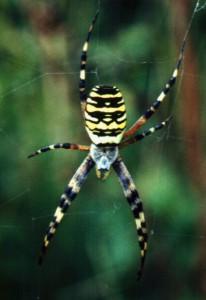The Wasp Spider, Argiope bruennichi

You cannot mistake for any other species this big, handsome spider, which spins in large orb webs in the open among long grass in southern England. It owes its common name its wasp-like markings, but unlike many a wasp, it is quite harmless and highly unlikely that it will hurt you. It is a relative of the Common Garden Spider, Araneus diadematus. Females can be very large with a body length of 2cm while males are much smaller, a mere 0.5cm long! Males can sometimes be found on a small thread close by a female and her large web.
Adults mature in August and September and it is at this time that the large webs of the females can be found. These can measure 30cm across. At the hub of the web is a characteristic vertical band of iridescent silk. Here the spider spends most of her time, waiting for prey to fly in. This band of silk may help to camouflage her. Crickets and grasshoppers are a favourite meal for the large females, but flies and other insects are also on the menu.
Mating is dangerous in all spiders, and particularly so in this species. After the male has initially ventured onto the female's web and seduced her, she usually wraps him in silk prior to eating him as he mates. His body provides valuable protein for the female who will then produce eggs. Once mated, the female lays her eggs and then spins a large, flask-shaped, brown egg-sac, somewhat resembling an up-turned Greek urn. This is generally hung in the vegetation near her web. Females die in the autumn. Young hatch from the eggs before winter, but do not emerge from the egg-sac until spring. The young spiderlings then grow and mature throughout the spring and summer.
Argiope was first recorded in Britain in 1922 when it was caught at Rye in East Sussex. The spider is now widespread in southern England coast and is rapidly spreading north. To breed it requires a minimum of three months warm weather and a mild winter. With the shift in our climate, these conditions are becoming increasingly more frequent.
